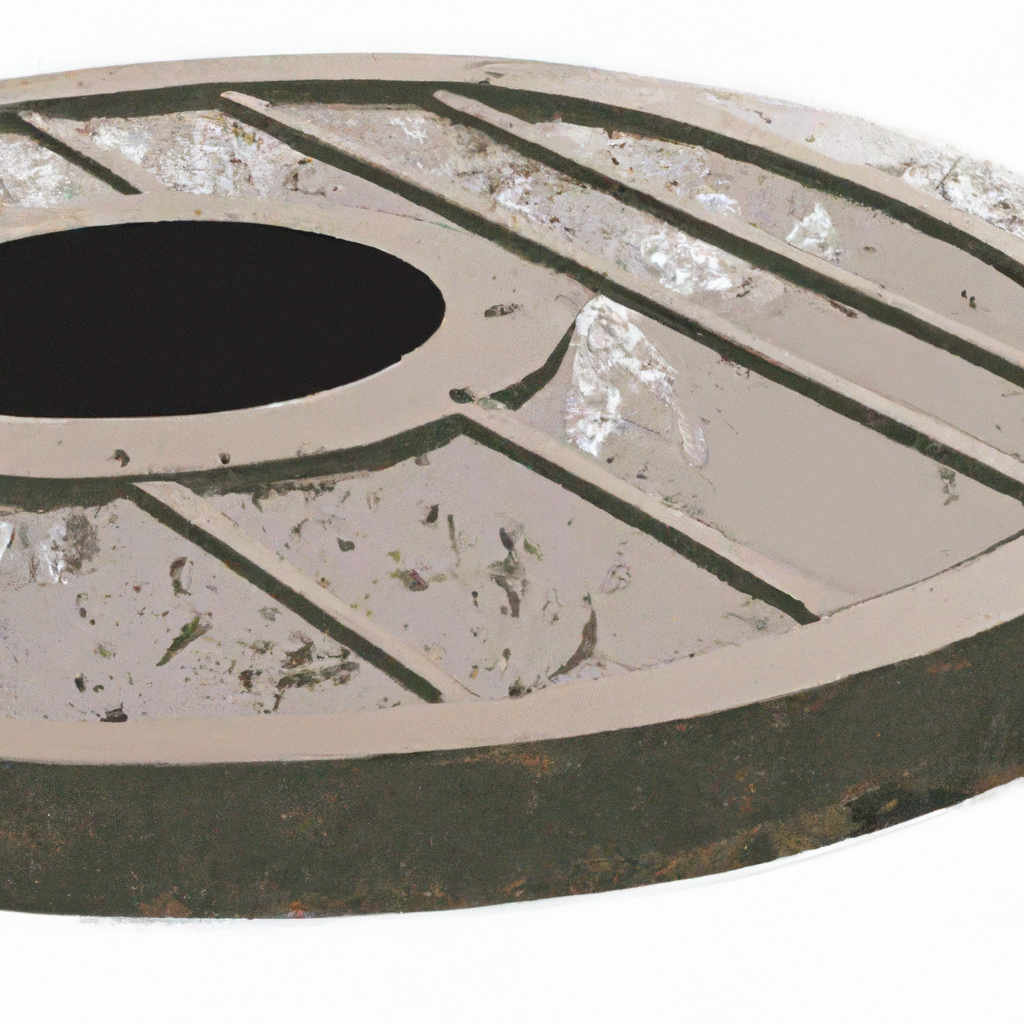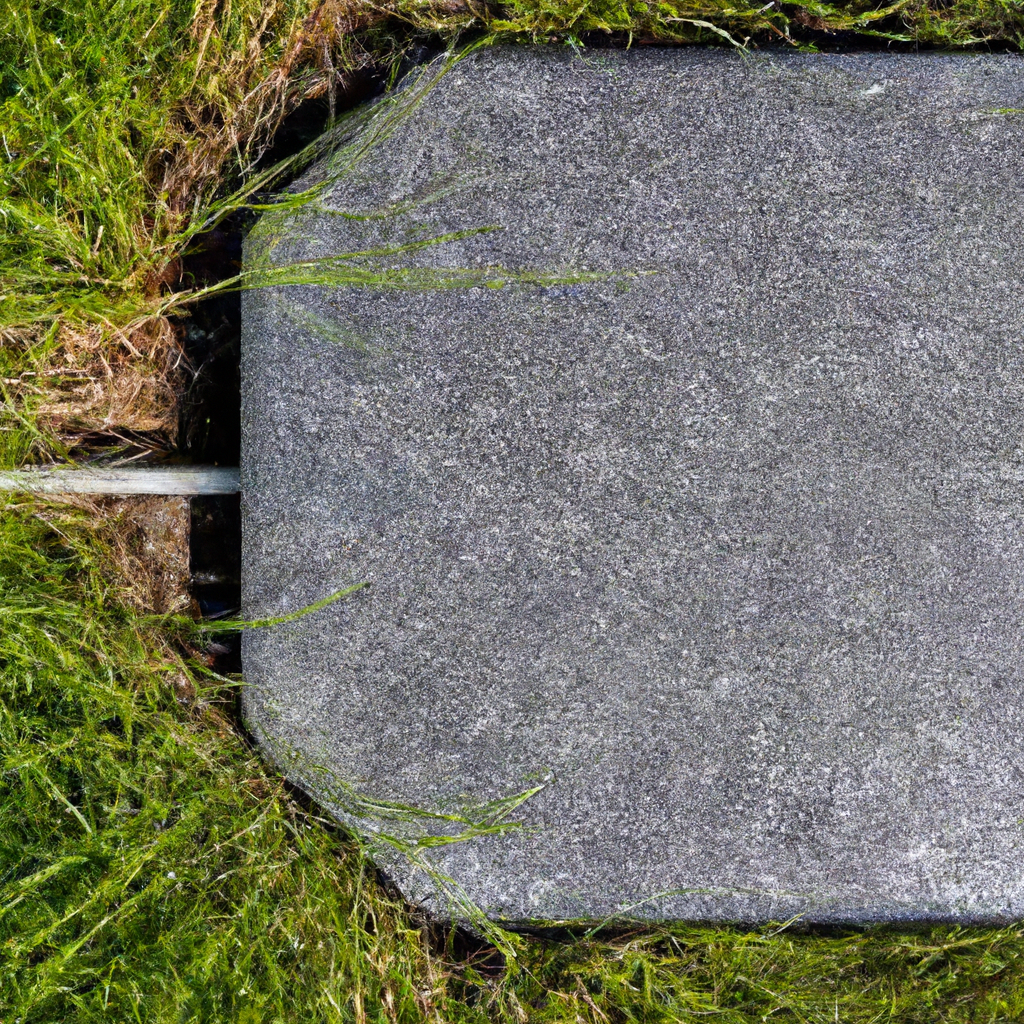Have you ever wondered about the cost of replacing a concrete septic tank lid? Well, look no further! In this article, we will uncover the answer to your burning question. Replacing a concrete septic tank lid is a necessary maintenance task that many homeowners face at some point. From the materials needed to the labor costs, we will explore all the factors that contribute to the overall cost of this crucial job. So, if you’re curious about how much it will set you back to replace a concrete septic tank lid, keep on reading!

The Basics of a Septic Tank
What is a Septic Tank
A septic tank is an underground wastewater treatment system that is commonly used in rural areas where there is no access to a centralized sewer system. It is designed to receive and treat waste from a household or building. The main purpose of a septic tank is to separate solids from liquids and to break down organic matter through a natural biological process.
Function of a Septic Tank
The function of a septic tank is to provide primary treatment to the wastewater that flows into it. When wastewater enters the tank, it undergoes a series of processes. First, the solids settle at the bottom of the tank, forming a layer of sludge. The fats, oils, and greases float on the surface, forming a layer of scum. The liquid, also known as effluent, is then discharged into the drainfield for further treatment in the soil.
Components of a Septic Tank
A septic tank consists of several components that work together to ensure the efficient treatment of wastewater. The main components include:
-
Inlet Pipe: This is where the wastewater enters the tank from the building. It is important for the inlet pipe to be properly positioned to prevent the disruption of the settled solids.
-
Septic Tank: The septic tank itself is a watertight container made of concrete, fiberglass, or plastic. It is where the wastewater is held and undergoes the treatment process.
-
Outlet Pipe: Once the wastewater has been treated in the septic tank, it flows out through the outlet pipe and into the drainfield.
-
Baffles: Baffles are located inside the septic tank and help to regulate the flow of wastewater. They help prevent the solids from escaping into the drainfield and ensure that the effluent is evenly distributed.
-
Septic Tank Lid: The septic tank lid provides access to the tank for inspection, maintenance, and pumping. It is usually made of concrete or plastic and is designed to be strong and durable to withstand the weight of the soil.
Understanding a Concrete Septic Tank Lid
Description of a Concrete Lid
A concrete septic tank lid is a thick, heavy slab made of reinforced concrete. It is placed on top of the septic tank to seal and protect the contents of the tank. Concrete lids are known for their durability and ability to withstand heavy loads, making them a popular choice for septic tank installations.
Role of a Concrete Lid
The primary role of a concrete septic tank lid is to prevent unauthorized access to the septic tank. It acts as a protective cover, ensuring that the contents of the tank remain undisturbed. Additionally, the lid helps to maintain the structural integrity of the septic tank by preventing soil from exerting excessive pressure on the tank walls.
Potential Issues with a Concrete Lid
While concrete septic tank lids are known for their durability, they are not without their potential issues. Over time, concrete lids may crack or deteriorate due to factors such as soil movement, freezing and thawing, or chemical exposure. These cracks can allow water to seep into the septic tank, potentially causing damage to the tank itself and compromising the effectiveness of the septic system.
The Lifespan of a Concrete Septic Tank Lid
How long a Concrete Lid Lasts
The lifespan of a concrete septic tank lid can vary depending on various factors, including the quality of the concrete, the installation process, and the maintenance practices. On average, a well-maintained concrete lid can last anywhere from 20 to 30 years.
Factors affecting Lifespan
Several factors can affect the lifespan of a concrete septic tank lid. These include:
-
Quality of Concrete: The quality of the concrete used in the construction of the lid can significantly impact its lifespan. High-quality concrete that is properly mixed and cured is more likely to resist cracking and deterioration.
-
Installation Process: The way the lid is installed can also affect its lifespan. If the lid is not properly supported or if the surrounding soil is not adequately compacted, it can lead to premature cracking or shifting of the lid.
-
Environmental Conditions: Environmental factors such as soil composition, temperature fluctuations, and exposure to chemicals or corrosive substances can accelerate the deterioration of a concrete lid.
Signs of Wear and Tear
It is important to regularly inspect your concrete septic tank lid for signs of wear and tear. Some common signs that indicate the need for a lid replacement include:
- Cracks or fractures on the surface of the lid
- Visible deterioration or crumbling of the concrete
- Uneven settling or shifting of the lid
- Water pooling on the lid or around the tank
- Excessive weight or pressure on the lid causing it to sag
If any of these signs are present, it is crucial to address them promptly to avoid further damage to the septic system.
When to Replace a Concrete Septic Tank Lid
Importance of Timely Replacement
Replacing a concrete septic tank lid in a timely manner is crucial to maintain the functionality and integrity of your septic system. Ignoring signs of wear and tear or delaying the replacement can lead to serious consequences, including:
-
Safety Hazards: A damaged or weakened lid can pose a safety risk, especially if someone accidentally falls through the opening. Timely replacement ensures the lid remains secure and prevents accidents.
-
Groundwater Contamination: A cracked or deteriorating lid can allow water to seep into the septic tank, potentially contaminating the groundwater. This can have severe environmental implications and may result in the need for costly remediation.
-
Malfunctioning Septic System: A compromised lid can lead to increased pressure on the septic tank, affecting its ability to properly treat and dispose of wastewater. This can result in backups, foul odors, and other septic system failures.
Warning Indications for Replacement
If you notice any of the following warning indications, it is a clear sign that your concrete septic tank lid needs to be replaced:
- Large cracks or fractures that compromise the integrity of the lid
- Excessive wear or decay, making the lid structurally unsound
- Movement or shifting of the lid, causing an improper seal
- Significant corrosion or rusting of any metal components of the lid
If you are unsure whether your lid needs replacement, it is best to consult with a professional septic system service provider who can assess the condition and recommend appropriate action.
Consequences of Delayed Replacement
Delaying the replacement of a deteriorating concrete septic tank lid can lead to significant consequences. Some of the potential consequences include:
-
Increased Repair Costs: Ignoring the problem and allowing the lid to further deteriorate can result in more extensive damage to the septic system. This can ultimately lead to higher repair costs and potentially the need for a complete system replacement.
-
Health Risks: A failing septic system can pose health risks to you and your household. Contaminated groundwater can spread harmful bacteria and pathogens, increasing the risk of waterborne diseases.
-
Environmental Damage: A malfunctioning septic system can release untreated wastewater into the surrounding environment, causing pollution and harm to local ecosystems. This can affect the quality of nearby water sources, soil, and wildlife.
It is essential to prioritize the timely replacement of a concrete septic tank lid to avoid these costly and potentially harmful consequences.

The Removal Process of an Old Lid
How to Remove a Concrete Septic Tank Lid
Removing an old concrete septic tank lid requires caution and proper techniques to ensure the safety of all individuals involved. Here are the steps to remove the old lid:
-
Prepare the Work Area: Clear the surroundings of the septic tank and ensure there is ample space to work safely. Remove any debris or loose soil that may interfere with the lid removal process.
-
Locate the Lid: Using a probe or septic tank locating device, determine the exact location of the lid. This will prevent unnecessary digging or damage to the tank itself.
-
Inspect and Evaluate: Before attempting to remove the lid, inspect it for any signs of damage or instability. Make sure there are no cracks, fractures, or other structural issues that may affect its removal.
-
Loosen the Lid: Use a pry bar or lid lifter tool to gently lift the lid. Apply even pressure and work your way around the edges to gradually loosen it from the septic tank.
-
Detach from the Tank: Once the lid is lifted, carefully detach it from the tank by sliding it to one side. Take note of any additional components or fixtures that may be attached to the lid, such as handles or risers.
Safety Measures in Removal
When removing an old concrete septic tank lid, it is crucial to prioritize safety at all times. Follow these safety measures to prevent accidents or injuries:
- Wear appropriate personal protective equipment, including gloves, safety glasses, and a mask, to protect yourself from potential hazards.
- Use proper lifting techniques when handling the lid to prevent strain or muscle injuries.
- Work in pairs whenever possible to ensure someone is available to assist or provide immediate help in case of an emergency.
- Avoid sudden movements or jerking motions when removing the lid to prevent accidents.
- Be aware of the weight and size of the lid to prevent it from falling or slipping during removal.
Disposing an Old Lid
Once the old concrete septic tank lid has been successfully removed, it is important to dispose of it properly. Due to its weight and size, it is recommended to consult local waste management authorities to determine the appropriate disposal method. In many cases, concrete can be recycled or disposed of at designated facilities.
Choosing a Replacement Concrete Septic Tank Lid
Qualities of an Ideal Replacement Lid
Selecting the right replacement concrete septic tank lid is vital to ensure the long-term functionality and durability of your septic system. Here are some qualities to look for in an ideal replacement lid:
-
Strength and Durability: The replacement lid should be made of high-quality materials, such as reinforced concrete or sturdy plastic, to withstand the weight of the soil and any potential external pressures.
-
Proper Fit: The replacement lid should be designed to fit the dimensions and specifications of your septic tank. It should provide a tight seal to prevent pests, groundwater, or debris from entering the tank.
-
Corrosion Resistance: If metal reinforcements are used in the lid, they should be designed to resist corrosion and rust to ensure long-lasting performance.
-
Easy Access for Maintenance: The replacement lid should have features that allow easy access for inspection, pumping, and maintenance purposes. This includes built-in handles, risers, or other convenient access points.
Where to Buy a Concrete Lid
Concrete septic tank lids can be purchased from various sources, including septic system service providers, hardware stores, home improvement centers, or online retailers. It is important to choose a reputable supplier that offers high-quality products and reliable customer support.
Factors to Consider When Buying a New Lid
When buying a replacement concrete septic tank lid, consider the following factors to ensure a suitable choice for your specific needs:
-
Size and Shape: Measure the dimensions of your septic tank accurately to find a replacement lid that fits perfectly. Consider any unique shape or design requirements of your septic tank.
-
Material and Construction: Choose a lid made of materials known for their strength, durability, and resistance to environmental factors. Pay attention to the construction details, such as reinforcements or sealants, that contribute to the lid’s quality.
-
Compatibility: Ensure that the replacement lid is compatible with your septic tank brand or model. Some manufacturers produce specific lids designed for their tanks, which may offer better compatibility and performance.
-
Cost and Warranty: Consider the cost of the replacement lid and compare prices from different suppliers. Additionally, check if the lid comes with a warranty or guarantee to protect your investment.

The Installation Process of a New Lid
Steps to Install a Concrete Septic Tank Lid
Installing a new concrete septic tank lid requires careful attention to detail and adherence to proper installation procedures. Follow these steps to install a new lid:
-
Prepare the Work Area: Similar to the lid removal process, clear the area around the septic tank and ensure a clean and level surface for installation.
-
Inspect the Tank: Before installation, inspect the septic tank itself for any signs of damage, cracks, or leaks. Address any necessary repairs before proceeding with the lid installation.
-
Apply Adhesive or Sealant: Depending on the design of the lid and tank, apply an appropriate adhesive or sealant along the edges of the tank to create a watertight seal.
-
Position the Lid: Carefully position the new lid on top of the adhesive or sealant, ensuring it is aligned properly with the septic tank opening. Avoid applying excessive pressure that could damage the lid or compromise the seal.
-
Secure the Lid: Use the recommended fasteners, such as stainless steel screws or bolts, to secure the lid in place. Follow the manufacturer’s instructions for the appropriate number and placement of fasteners.
-
Inspect the Seal: After securing the lid, examine the seal between the lid and the tank to ensure a proper fit and avoid any potential leaks or seepage. Make any necessary adjustments or additional sealing as needed.
Tools Needed for Installation
The installation of a new concrete septic tank lid requires the following tools:
- Screwdriver or drill with appropriate bits
- Tape measure or ruler
- Level
- Adhesive or sealant (appropriate for septic tank installations)
- Fasteners (screws or bolts)
- Safety gloves and glasses
Ensure you have all the necessary tools and equipment before starting the installation to avoid any unnecessary delays.
Safety Tips during Installation
During the installation process, it is important to prioritize safety to prevent accidents or injuries. Follow these safety tips:
- Handle the lid with care to avoid strains or injuries. Use proper lifting techniques and enlist the help of others when necessary.
- Use appropriate personal protective equipment, such as gloves and safety glasses, to protect yourself from potential hazards.
- Avoid rushing or applying excessive force during the installation. Take your time to ensure the lid is properly aligned and secured.
- Be cautious of your surroundings and avoid stepping or standing on unstable surfaces or near the septic tank opening.
Cost of Replacing a Concrete Septic Tank Lid
Price Range of New Concrete Lids
The cost of replacing a concrete septic tank lid can vary depending on several factors, including the size, design, material, and brand of the lid. On average, the price range for a new concrete lid can be between $200 and $500 or more.
Labor Cost for Replacement
In addition to the cost of the replacement lid itself, there may be additional labor costs involved in the replacement process. The labor cost can vary depending on the complexity of the installation, the location of the septic tank, and the accessibility of the lid. Generally, labor costs for replacing a concrete septic tank lid can range from $300 to $800 or more.
Additional Costs Involved
When budgeting for the replacement of a concrete septic tank lid, it is important to consider any additional costs that may arise. Some possible additional costs might include:
-
Permit Fees: Depending on your local regulations, permits may be required for septic system work, including lid replacement. These permits may come with associated fees that should be taken into account.
-
Site Preparation: If the site surrounding the septic tank requires any excavation, leveling, or removal of obstructions, additional costs may be incurred.
-
Professional Services: If you choose to hire a professional septic system service provider for the installation, there may be additional charges for their expertise and labor.
It is advisable to obtain quotes from multiple suppliers or service providers to get a better understanding of the total cost involved in replacing your concrete septic tank lid.

Ways to Reduce the Cost of Replacement
DIY Replacement Method
One way to potentially reduce the cost of replacing a concrete septic tank lid is to consider a DIY replacement method. If you have the necessary skills, equipment, and experience, you may be able to tackle the installation yourself. However, it is important to ensure you have a solid understanding of the proper installation procedures and follow all safety guidelines.
Buying Local Lids
Another way to reduce the cost is to explore purchasing lids from local suppliers or manufacturers. Buying local can often save on shipping costs and provide you with the opportunity to inspect the lid before purchasing. Additionally, local suppliers may offer more competitive pricing compared to larger retailers.
Negotiating Labor Cost
If you decide to hire a professional for the lid replacement, consider negotiating the labor cost. Obtain multiple quotes from different providers and compare their services, warranties, and price estimates. Use this information to negotiate with them for a more favorable labor cost. However, it is important to ensure that you are still receiving high-quality workmanship and materials.
Maintenance Tips for a Concrete Septic Tank Lid
Regular Inspection of the Lid
Regularly inspecting your concrete septic tank lid is crucial to identify any signs of wear and tear early on. Perform visual inspections every few months or after heavy rain events. Look for cracks, shifting, or any other visible damage. If you notice any issues, address them promptly to prevent further deterioration.
Avoiding Heavy Objects on the Lid
To prevent unnecessary stress or damage to the lid, avoid placing heavy objects on top of it. Parking vehicles or machinery over the lid should be strictly avoided. Excessive weight can cause cracking or shifting, compromising the integrity of the lid and potentially damaging the septic system.
Cleaning Methods for Longevity
Regular cleaning around the lid area can help prevent debris build-up and potential damage. Use a soft brush or broom to remove any dirt, leaves, or other debris from the lid surface. Avoid using harsh chemicals or high-pressure washing, as these can erode the concrete or compromise the seal. If necessary, consult professional septic system service providers for recommendations on safe cleaning methods.
By following these maintenance tips, you can help prolong the lifespan of your concrete septic tank lid and ensure the continued functionality of your septic system. Regular inspections and maintenance will also help identify any potential issues before they become significant problems, saving you time and money in the long run.
In conclusion, understanding the basics of a septic tank, the role of a concrete septic tank lid, and the importance of timely replacement are essential for homeowners with septic systems. By knowing the signs of wear and tear, the removal and installation processes, as well as the cost considerations, you can make informed decisions regarding the replacement of a concrete septic tank lid. Remember to prioritize safety at all times and regularly maintain the lid to ensure the longevity and proper functioning of your septic system.

